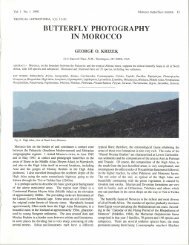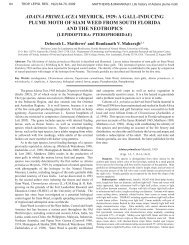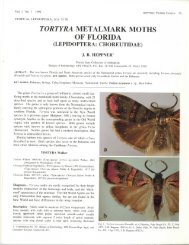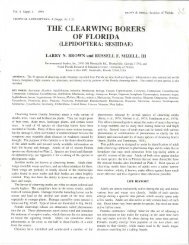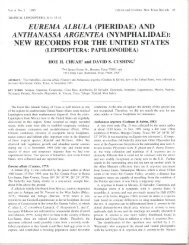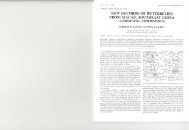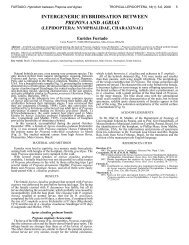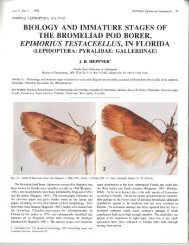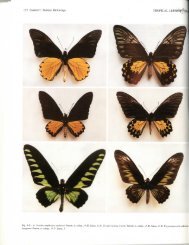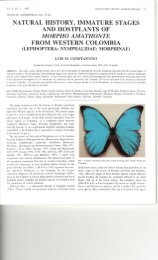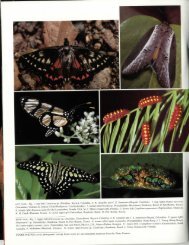A. Dantchenko, A. Sourakov, and T. C. Emmel Egg Structure and ...
A. Dantchenko, A. Sourakov, and T. C. Emmel Egg Structure and ...
A. Dantchenko, A. Sourakov, and T. C. Emmel Egg Structure and ...
You also want an ePaper? Increase the reach of your titles
YUMPU automatically turns print PDFs into web optimized ePapers that Google loves.
PLATE 2. (I) Neozephyrtls u/rrall/orillus Fixsen: (a) male; (b) male underside; (e) female: (2) N. ((ui/a Bremer: (a) male; (b) male underside; (e) female; (3) N. saphirillllsSiaudinger: (a) male; (b) male underside; (e) female; (4) N. querClls L.: (a) male; (b) male underside; (e) female; (5) Wagill/o sigllara quercivora Staudinger: (a) male;(b) male underside; (6) Fix.
Vol. 2 o. I 1995 DA TCHE KO et al.: <strong>Egg</strong> of Ru sian Theclinae 33food in case of a crisis with the original foodplant population. Aimilar example of such an occurren e in onh America wouldbe the Schaus swallowtail (Papi/io aristodemus pOllceallusSchaus) (papilionidae) in southern Aorida. BUllernies of thispecie normally lay egg only on torchwood (Amyris e/emifera)(Rutaceae), which i rather rare in its u ual hardwood hammockhabitat. Larvae are capable of feeding on wild lime (ZallthoxylemJagara) (Rutaceae), present in the area in abundance.However, wild lime i utilized as a foodplant in nature onlyocca ionally.eozephyrus quercus (Linnaeus) (Fig. IC <strong>and</strong> 4(4». Thispecie is found in the European pan of Russia. The larva feedon Quercus robur L. (Fagaceae); the female lays olitary egg,usually in the corner formed by the union of the bud <strong>and</strong> the stem(Fig. 71). The fir t instar larva bores into the bud, which i tillclosed. In later in tar, the larvae (Fig. 8B) strongly resemble thescales of the bud <strong>and</strong> stay next to them. Flight period of adultsvaries geographically, but u ually occurs in the econd half of thesummer. In the present work (sec following), this specie icompared with its eastern analogous species, NeozephYl"LIssaphirillus ( taudinger).Neozephyrus saphirinus ( taudinger) (Fig. IA) is very similarto N. quercus in appearance <strong>and</strong> biology (Fig. 2(3) <strong>and</strong> Fig. 3 ).The food plant of N. saphirillus is Quercus delltata (Fagaceae),which leafs out two weeks after the leaf-sprouting of Q. mOllgo/ica,a pecie analogous in phenology to the food plant of N.quercus in Europe. So despite the morphological re emblancebetween the two bUllerny pecie, N. saphirillus adults appearlater in a panicular ea on due to their association with thelower-leafing Q. dentata. The egg is shown in Fig. 5 .eozephyrus aquamarilllls DubatoIov & ergeev (Fig. ID).<strong>Egg</strong> (Fig. 5 ) were obtained from a live female <strong>and</strong> rai ed onEuropean Quercus robur (Fagaceae). We have not seen typematerial of thi species, so the identi fication of this specie isambiguou. The population of female adults obtained from ourlaboratory rearing is very close in appearance to N. aquamarinus.However, males are 0 unu ual that they do not fit the de criptionof any known taxa, including N. aquamarillus. Their genitalia,however, fit the de cription of N. aquamarillus. Under thelaboratory condition, female laid eggs primarily on the buds.Fir t instar larvae are similar to other species of this group. Thela't instar larva (Fig. 3C) is dark grey, <strong>and</strong> most of the time thislarval stage stays on thick branches, feeding only at night.Neozephyrus sp. This species is clo e to Favollit,s macrocercusWakabayashi <strong>and</strong> Fukuda from Korea, but that pecies ha notbeen fund on the territory of Russia. Adults <strong>and</strong> immaturetage of our population are significantly different. The discussionof the taxonomic status of this species will follow. <strong>Egg</strong>swere collected at the edge of the fore t on large, 7-8m high, treeof Quercus mOllgo/ica (Fagaceae). The egg is hown in Fig. 6L.Chrysozephyrus brilliLlntinus (Staudinger). The eggs are laidsolitary on the nower buds of Quercus //Iongo/ica (Fagaceae) inthe open areas <strong>and</strong> in the forest. The larva (Fig. 8C) of thipecie feed on oak eventhough other Theclini species of thisgroup (e.g., C. smaragdinL/s. C. yoshikoae. C. /inae, <strong>and</strong> C. gaOl),are found on Ro aceae. Chrysozephyrus brilliami/llls, describedby Staudinger, was ynonymized by Shirozu <strong>and</strong> Yamamotounder the name C. aurorillus (Oberthiir). ChrysozephyrusallrorillUS wa de cribed from Oskold Isl<strong>and</strong> from a female,which ha red <strong>and</strong> blue patche on the front wings. 0 typespecimens are known. The pecies described as C. smaragdill/ls,C. brillialltilll/s <strong>and</strong> C. korshullovi all fit the original de criptionof C. aurorinus. Thu . C. brilliantinus is not even mentioned inTuzov's (1993) list becau e its taxonomic tatus i not clear. Inour opinion, it is a good species, who e name hould be revived.Ussuriana michaelis michaelis (Oberthiir). Larvae feed onFraxillus rhYllchophylla Hance (Oleaceae). <strong>Egg</strong> (Fig. 6E) wereobtained under laboratory conditions. The female' ovipo itor itwice a long a its abdomen <strong>and</strong> normally i hidden inside theabdomen. Before laying an egg, a female look for a deep gapin the bark. She in ert her ovipositor into thi cavity <strong>and</strong> laysan egg. The last in tar larva of a Chine e population of thisspecie is illustrated in Koiwaya (\ 993). We think that thepopulation examined by Koiwaya is imilar to our population.Adults ny at the end of July, feeding on Umbelliferae. BUllerniesspend their non-feeding time in the canopy.Shirozua jonasi (Janson). According to our observation,females lay eggs alway on the ant paths on the trunk of Quercllsmongo/ica (Fagaceae). Larvae of the last instar feed on aphidson leaves <strong>and</strong> branche. They are colored purple-brown <strong>and</strong>con tantly are tended by ants. Placed in the cage together withlarvae of other specie of butternies, however, the larvae ofShiro::'/la jonasi attacked molting <strong>and</strong> sick individual <strong>and</strong> consumedthem. Adult hatch in the fir t ten days of August.Thecla betu/a crassa Leech (Fig. IH <strong>and</strong> Fig. 4( I». Larvae feedon Prulllls padlls L. <strong>and</strong> PrIIllllS spinosa L. (Rosaceae) in theEuropean part of Russia. Our population feed on apricot,Armelliaca mallchurica Maxim. (Ro aceae), <strong>and</strong> ometimes onPI"LIIlUS asiatica Kom. <strong>Egg</strong> (Fig. 5C) are laid olitarily, orometime in pairs on the tern or at the branching point of youngplant, or ometime on the lower branche of the older tree .The larva comes out of the egg, a in most member of thisgroup, in early pring <strong>and</strong> feeds on the leave from ju t-openedbuds. Later instar feed ,on the leave, sitting on their upperurfaces. The mature larva (Fig. 3K) pupates in the liller on theground. This pecie occur all over Ru ia, but the subspeciesT. b. crassa i restricted to the Amur <strong>and</strong> Ussuri di tricts.Thecla belL/lilla Staudinger is similar to T. bew/a morphologically<strong>and</strong> biologically. The larva (Fig. 3E) feeds on Ma/us manelll/rica Maxim. (Rosaceae) <strong>and</strong>, starting from the second instar, rollsthe leaf, forming a tube. inside which it spends mo t of the time.The larva pupate on the ground. Adults ny in August in theunderstory on the edge of the forest. Fig. 6J hows the egg.Artropoetes pryeri pryeri Murray lays egg in groups of 3-5 onold hoots of I-3m high Syrillga amurellsis Rupr. (Ro aceae).Adults ny in early July in open areas of the fore t.DlSCU SIO OF EGG DlFFERE CESIn thi review of a eries of clo ely related Theclini peciesfrom the Primor'e region of Russian Far East, we found that theegg morphology i the mo t u eful character for differentiating<strong>and</strong> grouping pecie. We u ed a Scanning Electron Microscope( EM) to examine the egg surface <strong>and</strong> micropylar region indetail. The following imilarities <strong>and</strong> differences were found.Echinoid eggs, with sharp pointed spine <strong>and</strong> bearing aeropyles(Fig. 7A) on circular rib, are found in the followingspecies: Neozephyrus quercus (Fig. 5E, O. 5mm), W. signata
PL TE 5. Micrographs ofeggs (magnification: IOOx). (A) AlI/igius blllieri Fenlon: (B) A. atrilia Brelller: (C) Thecla be/ulae L.: (D) Chrysazephyrus bri//ialllinus Slaudinger;(E) Neazeplryrus quercus L.: (F-G) IVagilllo sigllalll quercil"Ora Slaudinger: (H) Neozeplryrus ui/mlllarinus Fixsen; (I) S/rJlllollidia eximia Fixsen; (1) Neozeplryrustaxi/a Bremer: (K) N. aquamarinus Dubalolov & Scrgeev: (L) N. saplririllus Slaudinger.
Vol. 2 o. I 1995 DA T HE KO el al.: <strong>Egg</strong>s of Ru sian Theclinae 35(Fig. 5F, 0.95mm), N. u/lramarillus (Fig. 5H, 0.89mm), N. laxi/a(Fig.5J, 0.95mm), N. aquamarilllls (Fig. 5K, 0.90mm), N.saphirillus (Fig. 5L, 0.75mm), N. japollicus (Fig. 6B, 0.70mm),<strong>and</strong> in the species nova of Neozephyrus (Fig. 6L, 0.90mm). InN. quercus, though, the spines are wider <strong>and</strong> Ie pointed. Themicropyle of the e egg are 4, 5, or 6-petaled ro ette (Fig.7E,F,G).The clo est in appearance to thi group i the egg of Chrysozephyrllsbrillialllilllls (Fig. 50, 1.10mm). However, the tuberculethere are not pointed. The micropylar area i a 6-petaled roseUesituated in the crater, not porous <strong>and</strong> situated in the middle as inother specie. The egg is larger than in other pecies. Cell aretetragonal in all of the above specie.In Antigills alhilia (Fig. 5B, 0.87mm) <strong>and</strong> A. butleri (Fig. 5A,0.85mm), tubercules become even wider <strong>and</strong> shoner, exposingrounded p rous hexagonal cell (Fig. 7H). <strong>Egg</strong>s in these specieare much nauer.Absence of pine is ob erved in Thecla belulae (Fig. 5C,0.90mm) <strong>and</strong> Thecla belulilla (Fig. 6J, 1.0mm). The micropylein T. belu/ae is a 3-petaled opening in the middle of the porousro eUe, with pores hidden in the deep inclined pockets (Fig. 7C).Cells are hexagonal.The egg of Araragi elllhea i very di tinct (Fig. 6C, O. Omm).The chorion bear long tubercule with wide triangular tips, <strong>and</strong>with the aeropyle opening in the middle. The micropyle is a6-petaled ro eue with pore similar to tho e in T. bell//ae (Fig.7B). Cell are hexagonal.<strong>Egg</strong> of Ussllrialla michae/is (Fig. 6E, 0.63mm) are spineless,with ribs <strong>and</strong> tetragonal porou cells. The micropyle is notdistinct.A imilar, only larger egg, is found in Fixsel/ia prlmi (Fig. 6F,0.90mm. The egg of F. heni (Fig. 6K, 0.93mm) is much moredi tinct, with c<strong>and</strong>le- haped tubercule on the cro - ections ofthe ribs, bearing aeropyle <strong>and</strong> a ro eue-shaped micropyle. Cellare mo tly triangular <strong>and</strong> highly porous.The egg of JapolJica /utea i pineless with hexagonal, highlyporou cells (Fig. 6G, 0.93mm). The micropyle i a 5-petaledroseUe.Long <strong>and</strong> sharp pine found on the egg of Slrymollidia latiorare typical for this group (Allyn, 1984). Unlike eggs of Neozephyrus,StrymolJidia egg have high ribs with numerou harpspines, which do not seem to bear aeropyles. Tetragonal cells areporcle s. The micropyle i a 4-petaled rosette (Fig. 60, 0.80mm).The SlIymollidia eximia (Fig. 51, 0.63mm) egg is similar to theabove, but ha a 5-petaled roseUe <strong>and</strong> horter spine.<strong>Egg</strong>s of Strymol/idia IV-a. w-album (Fig. 6H, 0.86mm) <strong>and</strong> S.IV-a. sUlschal/i (Fig. 61, 0.86mm) are very di tinct. The lauermight be a good species, even based on this character alone.Both specie' egg have low rib, with cell edges formingtetragonal ribs with low thin pines. The egg of S. IV-a. slllschallii more rounded, with more distinct rib, than in the Europeanubspecie. The micropyle isa 5-petaled roseue.DISCUS 10The first auempt to u e egg hape for y tematics was byDoherty (I 86). Unfortunately, his great collection wa lost. Hiapproach to systematic was unconventional for the time, whensy tematics was ba ed entirely on adult morphology. The y temwhich he proposed on the ba i of egg tructure corre pond 0well with modern systematics that it is almost inexplicable whyegg structure is not commonly u ed in Lycaenidae y tematic .Doherty wrote: "When the ovation i tudied, the e genera fallinto convenient groups, defined by con tant <strong>and</strong> peculiar forms ofegg. I am aware that this classification i not likely to becomea popular one: the student will always prefer to separate hisgenera by an artificial key based on venation. But that the egroups of mine are natural one, <strong>and</strong> indicate in mo t ca e thetruth of descent, I do not doubt."Species studied in the pre ent work fall nicely into three groupidentified by Doheny:I. Arhopala (eggs with tetragonal sculpture):a. semispheric egg with strongly developed pines: S. iLicis, S.eximia, S. lalior, N. laxila, N. japonicus, N. ullramarinus, N.quercus, N. saphirinus, N. aqllamarinus, N. sp., W. signala, C.brilliafllinus.b. disc-shaped egg with well developed ribs: U. michaelis, S.w-album.2. Aphnaeus/Loxura (eggs with hexagonal sculpture)a. semispheric egg with well developed ribs: A. aI/ilia, A. bUlleri,A. ell/hea, T. bellllae, T. bellliina.b. smooth, di c- haped egg: J. IlIIea, J. onoi, J. sapesiriata.3. Thecla (trigonal or isometric hexagon): S. jonasi, F. herzi, F.pmni.It seem remarkable that 0 many pecic are 0 similar in theirlife cycle. We found egg of eight species of Theclini on a singletree of Quercus lIIolIgolica. Thi i an excellent example of ahighly pecialized community, in which every pecie i very welladapted to its particular niche. Thi excellent degree of adaptationcan be een in the oviposition preferences of every specie,regarding the place where the egg is laid on the branch, as wellas the di tance from the ground of the branch chosen forovipo ition.The larval behavior is even more pecialized, with the varioutaxa falling into distinct groups: larvae feed at night (N. orienlalis)or during the day; larvae feed on the nower (w. signata, N.laxi/a, C. brillialllil/lIs, N. oriel/la/is) or on the leaves (A. atti/ia,A. blllieri, J. /lIIea); when feeding on the leave, larvae occupyupper ide (T. bell/lae, F. prul/i, S. ilicis, A. allilia, A. blllieri) orunderside of the leaf (J. hllea); orne larvae are a ociated withants <strong>and</strong> aphids (S. jOl/asi), while others feed olitarily.We lack dctailed comparative information on the adult biology,but from what we have observed to date, there are certainparticularities in the type of the forest in which each of thespecies is found, as well as in utilized nectar sources <strong>and</strong> thenight period.ACKNOWLEDGME TSWe would like to thank L. ikolaev kiy for discu sion oftaxonomy <strong>and</strong> biology of the group <strong>and</strong> for providing us withvaluable information; . Sergeev, A. Chuvilin, V. Siniaev, <strong>and</strong> S.Kunitsin for help in collecting the eggs; V. Konovalov for hishelp in our housing at Riazanovka; <strong>and</strong> U. Eit chberger <strong>and</strong> O.Gorbunov for their help in obtaining the literature. Chri tine M.Eliazar kindly prepared revi ions of the manu cript. Thiresearch <strong>and</strong> its publication was supported by the LepidopteraRe earch Fund of the Univer ity of Florida Foundation.
38 DA TCHE KO el al.: <strong>Egg</strong>s of Russian Theclinae HOLARCTIC LEPIDOPTERA,PLATE 8. Last instar larvae: (A) Neoze,Jhyru., ul/ramarilllls Fixsen: (B) N. quaeu.' L.; (C) Chr)'sozephyrus brilliall/imls Staudinger; (D) N. .flIphirillusN. /(Jxi/a Bremer; (F) Amigius auilia Bremer: (G) Wagimo s'glla/(J quereivora Staudinger.taudinger: (E)Janson, O. E.1878. Remarks on Japanese Rhopalocera, with description of newpecies. Cist. Ellt. (Berlin), 2):269-274.Koiwaya, S.1993. Siudies of Chillese Buttelflies. Vol. 2. Tokyo. 230pp.Kurentsov, A. 1.1970. Buttelflies of the Far East. Moscow: Acad. Sci. U.S.S.R.163pp.Leech, J. H.1893-94. Butterflies from Chilla, Japall alld Corea., Part 1/: L)'caellidae,Papiliollidae, alld Hesperidae. London. Pp. 369-393.Murayama, .197. Some buuernies from suri. U.S.S.R.. <strong>and</strong> Korea. withdescription of new specie. T)'o to Ga (0 aka). 29: 159-163.Oberlhiir, C.1880. Fauna des Lepidoptere de I'lie A kold. Ell/des Ellt. (Rennes),5:11-88.Pryer, H.1886-88. Rhopalocera Nihollica: A Descriptioll of the Butterflies ofJapall. Part II. p. 13-15. Yokohama.Riley, N. D.1921. Some undescribed Rhopalocera from Mesopotamia <strong>and</strong> N. W.Persia <strong>and</strong> other nOles. AIlII. Mag. Nat. Hist. (London), 9(8):591-600.1939. Notes on Oriental Theelinae (Lep. Lycaenidae) with descriptionsof new species. Novil. Zoo/. (Tring), 41 :357.1958. The genera of Holarctic Theelinae: a tentative revision. Proc.10th flllemat. COllgr. EIII., MOlltreal, 1:281-2aigusa, T.1993. Zephyrus Research. o. I (March 5): 1-22.Scott, A. J.1986. The Butterflies ofNonh America. Stanford: Stanford Univ. Pr.583pp.Shirozu, T., <strong>and</strong> H. Yamamolo1956. A generic revi ion <strong>and</strong> the phylogeny of the tribe Theelini(Lepidoptera: Lycaenidae). Sieboldia (Fukuoka). 1(4):329-421.Sibatani, A.1992. Ob ervations on the period of active night in males ofFavollius (Lycaenidae) in South Primorie, the Russian Federation.T)'o To Ga (Osaka), 43:23-34.ibatani, A., <strong>and</strong> S. Ito1942. Beitrag zur Systematic der Theelinae im Kaiserreich Japanunler besonderer Berucksichtigung der sogennaten GallungZephyrus (Lepidoptera: Lycaenidae). Tellthredo (Kyoto),3:318-328.Shin, Y. H.1970. Life history of Ussurialla michaelis Oberthtir in Korea. TyoTo Ga (Osaka), 21: 15-16.Tuzov, V. K.1993. The S)'lIoll)'mic List of Butterflies from the ex-U.S.S.R.Moscow: Rosagroservice. 73pp.Yokoyama, M., <strong>and</strong> M. Wakabayashi1967. Colored llIustratioll of the Buttelflies of Japall. 0 aka:Hoikusha. 17 pp.



